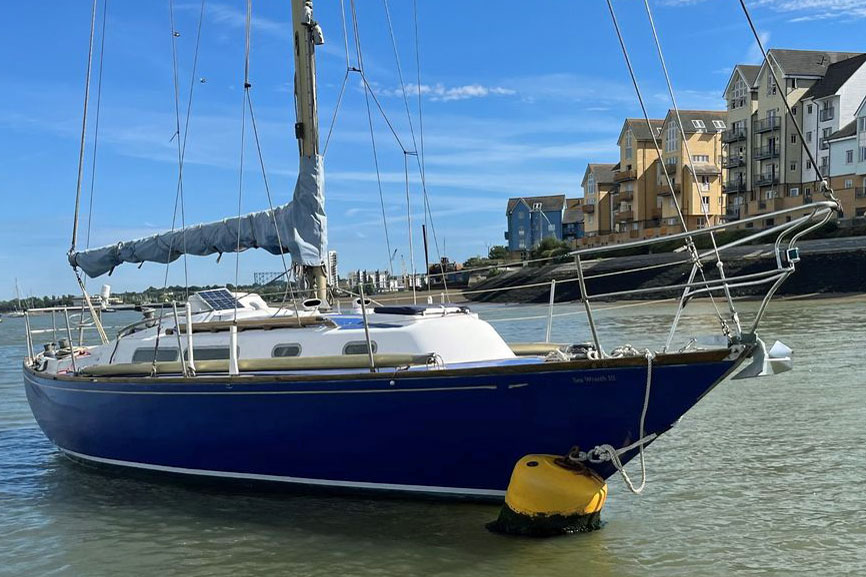- Home
- Cruising Yachts 35' to 40'
- Hustler 35
The Hustler 35 Sailboat
Specs & Key Performance Indicators
The Hustler 35 is a distinguished sailing yacht designed by Don Pye of the renowned British design firm Holman & Pye. This model embodies a combination of performance and cruising capabilities, characteristic of the designs from the 1970s.
The Hustler 35 was constructed by Landamores, a boat builder based in Wroxham, Norfolk. Landamores has been notable for their craftsmanship in building both racing and cruising yachts, and the Hustler 35 remains a testament to this legacy.
 A Hustler 35
A Hustler 35Published Specification for the Hustler 35
Underwater Configuration: Fin Keel & Skeg-Hung Rudder
Hull Material: Fiberglass
Length Overall: 10.52 meters (34.5 feet)
Waterline Length: 7.62 meters (25 feet)
Beam: 3.00 meters (9.84 feet)
Draft: 1.68 meters (5.5 feet)
Rig Type: Masthead Sloop
Displacement: 4,309 kilograms (9,500 pounds)
Designer: Don Pye of Holman & Pye
Builder: Hugh McManus & Tyler Boat Co. Ltd.
Year First Built: 1971
Year Last Built: 1980
Number Built: Approximately 86 units
Most of the Hustler 35s were built with a layout to suit a race crew, with lots of sea berths and sail bins up front. A few were built as cruisers with a U-shaped table/settee arrangement.
Published Design Ratios for the Hustler 35
- Sail Area/Displacement Ratio (14.8): This ratio, sitting at 14.8, suggests that the Hustler 35 has a moderate power-to-weight ratio. It is just below the threshold that defines reasonably good performance (16-20), indicating that while it may not be highly powered, it should perform adequately in most conditions.
- Ballast/Displacement Ratio (47.3): A ballast-to-displacement ratio of 47.3 suggests a relatively high degree of stiffness, as it exceeds the 40 threshold often associated with boats that can effectively resist heeling under wind pressure. This implies that the Hustler 35 should be able to carry its sails well in a breeze. However, it's essential to note that this ratio doesn't consider the distribution of ballast (e.g., deep vs. shallow keel), which can significantly affect performance and safety.
- Displacement/Length Ratio (312.4): With a displacement/length ratio of 312.4, the Hustler 35 falls into the category of "Heavy Displacement". Boats in this category generally provide smoother rides in rough water but may not be as responsive or as fast as lighter displacement vessels. This suggests that the Hustler 35 is designed more for comfortable cruising rather than high-speed racing.
- Comfort Ratio (27.9): Falling within the range of 20 to 30, the Hustler 35 is categorized with a motion typical of a coastal cruiser. This implies a reasonable level of comfort for most sailing conditions, particularly favored in more protected waters, but also capable of handling moderate bluewater conditions when necessary.
- Capsize Screening Formula (1.9): A rating of 1.9 in the Capsize Screening Formula illustrates that the Hustler 35 has characteristics favorable for ocean passages, suggesting an inherent stability and reduced likelihood of capsize compared to boats with higher numbers.
These calculated design ratios serve as theoretical indicators of the boat's performance and characteristics and do provide valuable insight. However, they can have limitations. Particularly, the Ballast/Displacement Ratio does not account for the placement of ballast, which can critically alter a boat's stability and performance. A deep keel with a bulb at the foot, for example, offers a much lower center of gravity compared to shallow draft boats, enhancing stability significantly.
Likewise, the Comfort Ratio, developed by Ted Brewer, doesn't always reflect the actual comfort experienced aboard, especially in modern designs. Newer boat designs with light displacements and wide beams may demonstrate surprising bluewater capability and comfort despite potentially lower traditional comfort ratios.
In summary, while the Hustler 35 demonstrates characteristics of a stable and comfortable cruiser with adequate performance capabilities, understanding these ratios' limitations and the practical implications of the boat’s specific design features (like hull form and keel design) is essential for a comprehensive view of its capabilities.
Read more about Design Ratios...
This article was written with the assistance of Gemini, a large language model developed by Google. Gemini was used to gather information, summarize research findings, and provide suggestions for the content and structure of the article.
Recent Articles
-
Sailboat Flag Etiquette: A Guide to International & Courtesy Flags
Oct 18, 25 04:02 AM
Master Sailboat Flag Etiquette with this definitive guide. Learn the rules for the Ensign, Burgee, and Courtesy Flag, plus sizing & legal compliance from an experienced ocean sailor. -
The Essential Blue Water Sailing Guide: Planning, Safety & Seamanship
Oct 17, 25 05:00 AM
The definitive Blue Water Sailing Guide from an RYA Yachtmaster. Master vessel preparation, offshore safety systems, watchkeeping, and long-distance seamanship. -
Preparing Your Sailboat for Storage: Hauling Out & Laying-Up
Oct 17, 25 04:26 AM
A guide to Sailboat Hauling Out & Laying-Up ashore. Learn the essential steps, from engine winterisation and safely positioning strops to managing damp & rigging, for a worry-free lay-up.












